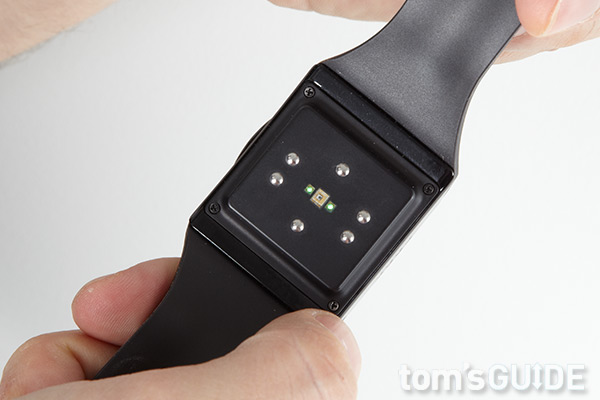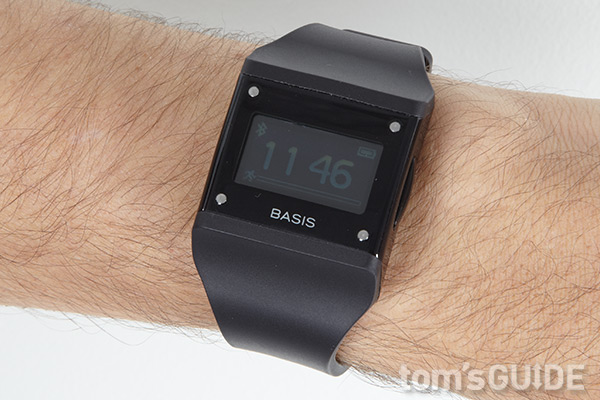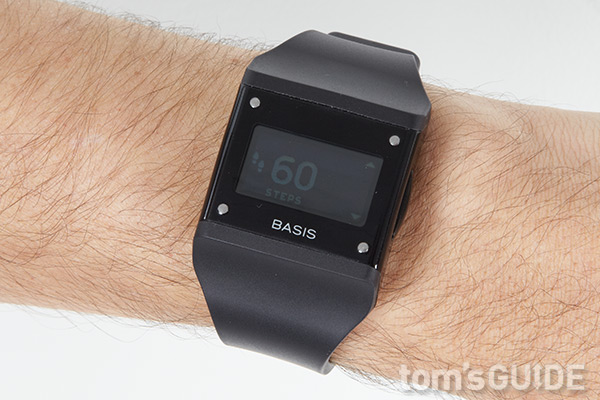Tom's Guide Verdict
Capable of tracking your heart rate, movement, sleep and even perspiration, the Basis B1 fitness band offers one of the most complete pictures of your overall fitness.
Pros
- +
Collects and displays a huge amount of data
- +
Tracks sleep automatically
- +
Measures heart rate
Cons
- -
Somewhat bulky
- -
Lacks alarm clock
Why you can trust Tom's Guide
Design, Setup, Watch Interface, Performance
One of the more important metrics when it comes to fitness is your heart rate. However, heart rate sensors are in very few wristband-style devices, which forces you to wear an uncomfortable chest strap. As a result, only more committed athletes ever bother to track this bit of data. Looking to change this is the Basis B1 Band, which incorporates not only a heart rate monitor, but other sensors that track your skin temperature, perspiration, sleep and movement. Is this $199 wristband a data lover's delight?
Design

Unlike the more rounded Mio Alpha wristband, which also tracks your heart rate, the Basis B1 Band has a somewhat boxy shape that makes it look a bit more industrial. Our review unit was all black, but a version with a white band is also available. Surrounding the small LCD are four silver circles the size of pinheads; these are actually touch-sensitive buttons used to navigate the Basis.
The bottom of the Basis has six metal studs surrounding a small sensor; these are used to measure your heart rate, perspiration and skin temperature.
On the right side of the watch is another button for navigating menus, and on the left side are four metal contacts that let you charge the watch when connected to the included USB charger.
MORE: Best Fitness Trackers

The Basis watch's plastic band was durable enough, but wasn't as comfortable as the soft-touch finish of the Mio Alpha’s wristband. Also, unlike smaller devices that also track sleep, such as the Misfit Shine, the Basis' larger size makes it more obtrusive when wearing it overnight. Not surprisingly, the Basis' weight of 1.4 ounces is greater than the Fitbit Force (1.15 ounces) and the 0.55-ounce Shine.
There’s nothing offensive about the Basis B1's design, but it looks somewhat bland. If you want a little more flair, Basis sells several straps on its website: a leather band with stainless steel accents ($49), two with a kaleidoscope and an "electric spring" pattern ($34), and an all-white band ($24).
Get instant access to breaking news, the hottest reviews, great deals and helpful tips.
Setup
After attaching the charger to the Basis B1, we plugged it into our laptop to start the setup process. We opened a Web browser to mybasis.com and set up an account. You can also download the iOS or Android app and pair the watch with your phone via Bluetooth.
Watch Interface

The four buttons on the face of the B1 watch control all the on-screen menus. The upper left button turns on the backlight; the lower left button lets you switch between the time and the date; and the two right buttons let you cycle between heart rate, steps and calories. Press the button on the right side of the watch to enter Bluetooth pairing mode.
While the Basis watch's LCD isn't as bright as the Mio Alpha, its backlight makes it sunlight-viewable, and we liked that it automatically activates when you raise your wrist.
However, as watch functions go, it's pretty basic, showing just the time and date. At the very least we wish it had an alarm clock, such as the Fitbit Force, which gently buzzes to wake you.
MORE: Mobile Security Guide: Everything You Need to Know
Performance

The Basis B1 Band uses what the company calls "Body IQ," that is, the ability to automatically detect the type of activity in which you’re engaged, be it walking, running, biking or sleeping. Throughout all these activities, the Basis watch monitors your heart rate, skin temperature and perspiration, to get a more accurate measurement of the amount of calories you burned than if you were just tracking movement alone.
After wearing it for a week or so, we found the watch tracked all of our movements, heart rate and other metrics fairly well. While it measures the number of steps you take, unlike other fitness bands, it doesn't show the distance covered in feet or miles. This is one metric we wish was included.
The band was as comfortable to wear as any traditional watch, though, as we mentioned earlier, is a little too bulky to continually wear overnight.
Follow Mike on Google Plus.
- 1
- 2
Current page: Basis B1 Band Review - Performance and Interface - Tom's Guide
Next Page Basis B1 Band Review - Sleep Tracking and Battery Life - Tom's Guide
Michael A. Prospero is the U.S. Editor-in-Chief for Tom’s Guide. He oversees all evergreen content and oversees the Homes, Smart Home, and Fitness/Wearables categories for the site. In his spare time, he also tests out the latest drones, electric scooters, and smart home gadgets, such as video doorbells. Before his tenure at Tom's Guide, he was the Reviews Editor for Laptop Magazine, a reporter at Fast Company, the Times of Trenton, and, many eons back, an intern at George magazine. He received his undergraduate degree from Boston College, where he worked on the campus newspaper The Heights, and then attended the Columbia University school of Journalism. When he’s not testing out the latest running watch, electric scooter, or skiing or training for a marathon, he’s probably using the latest sous vide machine, smoker, or pizza oven, to the delight — or chagrin — of his family.

